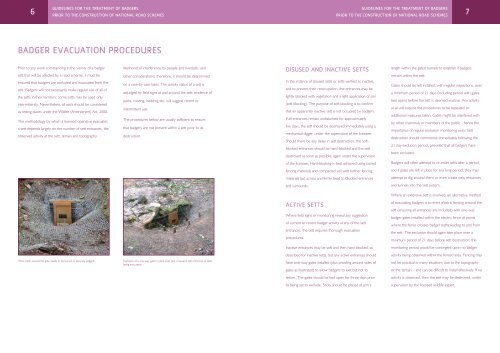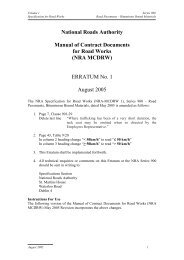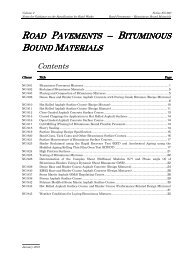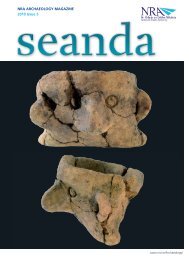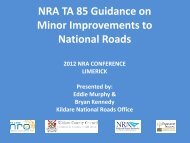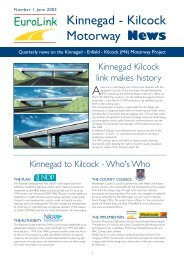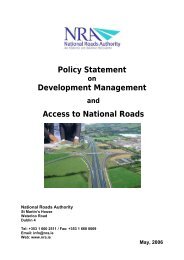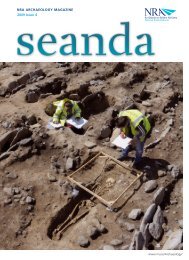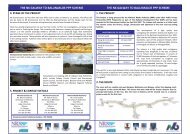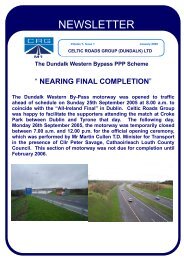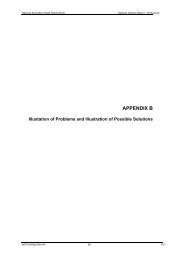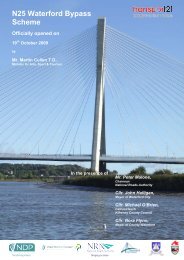Guidelines for the Treatment of Badgers Prior to - National Roads ...
Guidelines for the Treatment of Badgers Prior to - National Roads ...
Guidelines for the Treatment of Badgers Prior to - National Roads ...
You also want an ePaper? Increase the reach of your titles
YUMPU automatically turns print PDFs into web optimized ePapers that Google loves.
6<br />
GUIDELINES FOR THE TREATMENT OF BADGERS<br />
PRIOR TO THE CONSTRUCTION OF NATIONAL ROAD SCHEMES<br />
BADGER EVACUATION PROCEDURES<br />
<strong>Prior</strong> <strong>to</strong> any work commencing in <strong>the</strong> vicinity <strong>of</strong> a badger<br />
sett that will be affected by a road scheme, it must be<br />
ensured that badgers are excluded and evacuated from <strong>the</strong><br />
sett. <strong>Badgers</strong> will not necessarily make regular use <strong>of</strong> all <strong>of</strong><br />
<strong>the</strong> setts in <strong>the</strong>ir terri<strong>to</strong>ry; some setts may be used only<br />
intermittently. Never<strong>the</strong>less, all setts should be considered<br />
as resting places under <strong>the</strong> Wildlife (Amendment) Act, 2000.<br />
The methodology by which a licensed operative evacuates<br />
a sett depends largely on <strong>the</strong> number <strong>of</strong> sett entrances, <strong>the</strong><br />
observed activity at <strong>the</strong> sett, terrain and <strong>to</strong>pography,<br />
Wire mesh around <strong>the</strong> gate needs <strong>to</strong> be buried or securely pegged.<br />
likelihood <strong>of</strong> interference by people and lives<strong>to</strong>ck, and<br />
o<strong>the</strong>r considerations; <strong>the</strong>re<strong>for</strong>e, it should be determined<br />
on a case-by-case basis. The activity status <strong>of</strong> a sett is<br />
adjudged by field signs at and around <strong>the</strong> sett: evidence <strong>of</strong><br />
paths, rooting, bedding etc. will suggest recent or<br />
intermittent use.<br />
The procedures below are usually sufficient <strong>to</strong> ensure<br />
that badgers are not present within a sett prior <strong>to</strong> its<br />
destruction.<br />
Examples <strong>of</strong> a one-way gate in place over one <strong>of</strong> several sett entrances at setts<br />
being evacuated.<br />
DISUSED AND INACTIVE SETTS<br />
In <strong>the</strong> instance <strong>of</strong> disused setts or setts verified as inactive,<br />
and <strong>to</strong> prevent <strong>the</strong>ir reoccupation, <strong>the</strong> entrances may be<br />
lightly blocked with vegetation and a light application <strong>of</strong> soil<br />
(s<strong>of</strong>t blocking). The purpose <strong>of</strong> s<strong>of</strong>t-blocking is <strong>to</strong> confirm<br />
that an apparently inactive sett is not occupied by badgers.<br />
If all entrances remain undisturbed <strong>for</strong> approximately<br />
five days, <strong>the</strong> sett should be destroyed immediately using a<br />
mechanical digger, under <strong>the</strong> supervision <strong>of</strong> <strong>the</strong> licensee.<br />
Should <strong>the</strong>re be any delay in sett destruction, <strong>the</strong> s<strong>of</strong>t-<br />
blocked entrances should be hard-blocked and <strong>the</strong> sett<br />
destroyed as soon as possible, again under <strong>the</strong> supervision<br />
<strong>of</strong> <strong>the</strong> licensee. Hard-blocking is best achieved using buried<br />
fencing materials and compacted soil with fur<strong>the</strong>r fencing<br />
materials laid across and firmly fixed <strong>to</strong> blocked entrances<br />
and surrounds.<br />
ACTIVE SETTS<br />
Where field signs or moni<strong>to</strong>ring reveal any suggestion<br />
<strong>of</strong> current or recent badger activity at any <strong>of</strong> <strong>the</strong> sett<br />
entrances, <strong>the</strong> sett requires thorough evacuation<br />
procedures.<br />
Inactive entrances may be s<strong>of</strong>t and <strong>the</strong>n hard-blocked, as<br />
described <strong>for</strong> inactive setts, but any active entrances should<br />
have one-way gates installed (plus pro<strong>of</strong>ing around sides <strong>of</strong><br />
gates as illustrated) <strong>to</strong> allow badgers <strong>to</strong> exit but not <strong>to</strong><br />
return. The gates should be tied open <strong>for</strong> three days prior<br />
<strong>to</strong> being set <strong>to</strong> exclude. Sticks should be placed at arm’s<br />
GUIDELINES FOR THE TREATMENT OF BADGERS<br />
PRIOR TO THE CONSTRUCTION OF NATIONAL ROAD SCHEMES<br />
7<br />
length within <strong>the</strong> gated tunnels <strong>to</strong> establish if badgers<br />
remain within <strong>the</strong> sett.<br />
Gates should be left installed, with regular inspections, over<br />
a minimum period <strong>of</strong> 21 days (including period with gates<br />
tied open) be<strong>for</strong>e <strong>the</strong> sett is deemed inactive. Any activity<br />
at all will require <strong>the</strong> procedures <strong>to</strong> be repeated or<br />
additional measures taken. Gates might be interfered with<br />
by o<strong>the</strong>r mammals or members <strong>of</strong> <strong>the</strong> public - hence <strong>the</strong><br />
importance <strong>of</strong> regular exclusion moni<strong>to</strong>ring visits. Sett<br />
destruction should commence immediately following <strong>the</strong><br />
21 day exclusion period, provided that all badgers have<br />
been excluded.<br />
<strong>Badgers</strong> will <strong>of</strong>ten attempt <strong>to</strong> re-enter setts after a period,<br />
and if gates are left in place <strong>for</strong> any long period, <strong>the</strong>y may<br />
attempt <strong>to</strong> dig around <strong>the</strong>m or even create new entrances<br />
and tunnels in<strong>to</strong> <strong>the</strong> sett system.<br />
Where an extensive sett is involved, an alternative method<br />
<strong>of</strong> evacuating badgers is <strong>to</strong> erect electric fencing around <strong>the</strong><br />
sett (ensuring all entrances are included) with one-way<br />
badger-gates installed within <strong>the</strong> electric fence at points<br />
where <strong>the</strong> fence crosses badger paths leading <strong>to</strong> and from<br />
<strong>the</strong> sett. The exclusion should again take place over a<br />
minimum period <strong>of</strong> 21 days be<strong>for</strong>e sett destruction; this<br />
moni<strong>to</strong>ring period would be contingent upon no badger<br />
activity being observed within <strong>the</strong> fenced area. Fencing may<br />
not be practical in many situations due <strong>to</strong> <strong>the</strong> <strong>to</strong>pography<br />
or <strong>the</strong> terrain – and can be difficult <strong>to</strong> install effectively. If no<br />
activity is observed, <strong>the</strong>n <strong>the</strong> sett may be destroyed, under<br />
supervision by <strong>the</strong> licensed wildlife expert.


